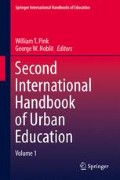Abstract
The majority of children with disabilities are out of school and living in deprived circumstances in Ethiopia. International Monetary Fund (The federal democratic republic of Ethiopia: Country report. IMF, Washington, DC, 2013) country report indicates that the population of Ethiopia is nearly 90 million while World Health Organization (World report on disability. WHO, Malta, 2011) report infers that Ethiopia has 17.5 % prevalence of disabilities. In line with the estimate, the recent national report of the country shows that only 77, 850 (0.6 %) of children with disabilities were enrolled in 2013/2014 academic year (Ministry of Education, Education sector development program 5: Program action plan. Ministry of Education, Addis Ababa, 2015). It is apparent that children with disabilities who are living in urban area gets more access to schooling where the schools have relatively better awareness and face pressure from the top education leaders to welcome children with disabilities. However, most urban schools seem to highlight the physical presence of children with disabilities and although are less equipped to provide appropriate educational services. The education policy given emphasis to address education of children with disabilities, however, indicators suggest that practicing inclusive education and implementing the education policy is not widely addressed. To examine the opportunities and major barrier in execution of inclusive education, this chapter qualitatively analyses the Ethiopian Education Policy, the Education Sector Development Programs and the Special Needs Education Strategy of Ethiopia in line with the execution of inclusive education in urban schools and examine the implementation barriers in schools of Addis Ababa. It recommends areas that might need attention for improvement which leads to successful inclusion.
Access this chapter
Tax calculation will be finalised at checkout
Purchases are for personal use only
References
ACPF. (2011). Educating children with disabilities in Ethiopia: Elements of a policy. Addis Ababa: The African Child Policy Forum.
Atnafu, A., Oucho, L., & Zeitlyn, B. (2014). Poverty, youth and rural-urban migration in Ethiopia. Migration out of poverty. Brighton: University of Sussex.
Central Statistics Authority. (2008). Summary and statistical report of the 2007 population and housing census. Addis Ababa: FDRE Population Census Commission.
Frederickson, N., & Cline, T. (2002). Special educational needs, inclusion and diversity. Buckingham: Open University Press.
International Organization for Migration. (2005). International migration and development: A global perspective. Geneva: IOM.
Lewis, I. (2009). Reaching the marginalized: Education for disabled people in Ethiopia and Rwanda. Background paper prepared for the Education for All Global Monitoring Report. UNESCO.
Ministry of Education. (1994). Education and training policy. Addis Ababa: Ministry of Education.
Ministry of Education. (2005). Education sector development program 3: Program action plan. Addis Ababa: Ministry of Education.
Minister of Education. (2007). Education statistics annual abstract (pp. 37–47). Addis Ababa: Minister of Education.
Ministry of Education. (2010). Education sector development program 4: Program action plan. Addis Ababa: Ministry of Education.
Ministry of Education. (2011). Education statistics annual abstract. Addis Ababa: Ministry of Education.
Ministry of Education. (2015). Education sector development program 5: Program action plan. Addis Ababa: Ministry of Education.
Ratanasiripong, T. N., & Chai, T. K. (2013). A concept analysis of attitude toward getting vaccinated against human papillomavirus. Nursing Research and Practice, 373805, 5.
Robinson, & Latchem. (2005). Teacher education: Challenge and change. In R. Bernadette & C. Latchem (Eds.), Teacher education through open and distance education: World view of distance education and open learning (Vol. 3). New York: RoutledgeFalmer.
Special Needs Education/Inclusive Education Strategy. (2012). Addis Ababa: Ministry of Education.
Thompson, D., Fisher, R. k., Purcal, C., Deeming, C., & Sawrikar, P. (2011). Community attitude towards people with disability: Scoping project. Sydney: Commonwealth of Australia.
UNESCO. (2001). Including the excluded: Meeting diversity in education. Paris: UNESCO.
UNESCO. (2006). EFA global monitoring report. Paris: UNESCO.
UNESCO. (2007). Education for all by 2015. Will we make it? Paris: UNESCO.
UNESCO. (2009). Policy guidelines on inclusion in education. Paris: UNESCO.
UNESCO. (2010). Reaching the marginalized. Education for all global monitoring report. Paris: Oxford University Press.
UNESCO. (2015). Global monitoring report: Where’s learning. Paris.
UNICEF. (2007). A human right-based approach to education for all. New York: UNICEF.
UNICEF. (2009). Children’s work and independent migration: A critical review. Florence: Innocenti Research Center.
Wondwosen, M., Yitayal, A., & Semahegn, M. (2014). Challenges and opportunities to implement inclusive education. Asian Journal of Humanity, Art and Literature, 1(2), 118–135.
World Health Organization. (2011). World report on disability. Malta: WHO.
Zemene, H. G. (2014). Paper presentation at the 2014 World Bank conference on land and poverty. Washington, DC, pp. 7–8.
Zint, M. (2002). Comparing three attitude-behavior theories for predicting science teachers’ intentions. Journal of Research in Science Teaching, 39(9), 819–844.
Author information
Authors and Affiliations
Corresponding author
Editor information
Editors and Affiliations
Rights and permissions
Copyright information
© 2017 Springer International Publishing Switzerland
About this chapter
Cite this chapter
Bekele Abdi, Y. (2017). Trends of Inclusive Education and Impediments in Urban Schools of Ethiopia. In: Pink, W., Noblit, G. (eds) Second International Handbook of Urban Education. Springer International Handbooks of Education. Springer, Cham. https://doi.org/10.1007/978-3-319-40317-5_4
Download citation
DOI: https://doi.org/10.1007/978-3-319-40317-5_4
Published:
Publisher Name: Springer, Cham
Print ISBN: 978-3-319-40315-1
Online ISBN: 978-3-319-40317-5
eBook Packages: EducationEducation (R0)

